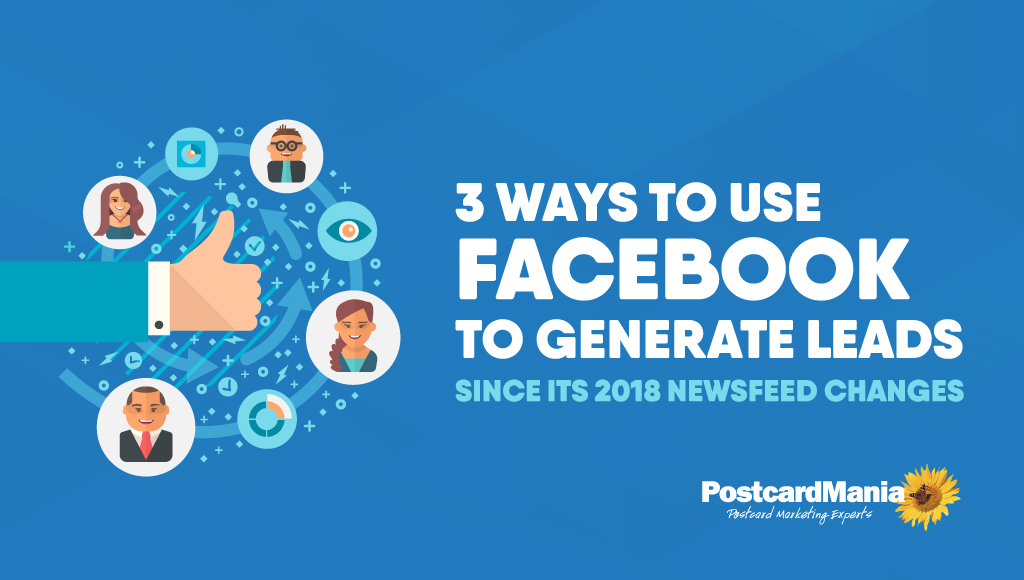
An integrated direct marketing approach that includes Facebook ads, online and offline campaigns will help you generate more leads on Facebook
Whether you love Facebook or can’t stand it, it’s clear this social media giant isn’t going anywhere anytime soon.
 Just check out these statistics:
Just check out these statistics:
- 27 billion people log into Facebook each month
- 79% of the U.S. population uses it (only 32% use Instagram)
- 53% of Americans reported accessing Facebook “several times per day”
- In some cases, this means 8 times per day (more than any other social media platform)
- 19% of time spent on mobile devices is on, you guessed it: Facebook
In short, your prospects VERY likely spend time on Facebook —Plus, many of them check in multiple times per day on its mobile app!
So what does this mean for marketing and growing your business?
You need to reach your prospects on Facebook, obviously, but I want you to read this caveat first…
If you thought you’d ask your office assistant to start putting up more posts on your business’s Facebook page and call it a day, think again. That approach may seem legitimate, but it actually won’t do the trick to get you new leads anymore. (Sorry, I know it stinks!)
In fact, putting up content on your business’s Facebook page won’t do much for your lead generation at ALL.
Here’s why:
Facebook limits how much organic content is shown to its users (your prospects) on their newsfeeds. By “organic,” I mean unpaid content. Posting a picture of your staff on your business’s Facebook page is an example of an organic post — you’re not paying for that post, you’re just posting it!
And because you’re not paying for it, Facebook isn’t prioritizing it in its newfeed.
 On average, 84% of people who hit “like” on your page are NOT seeing any posts you put up, and that figure is from 6 years ago! Today, that statistic is likely much HIGHER because in January 2018, Facebook announced changes to its newsfeed algorithms stating they intend to show more updates from your family and friends — and less from businesses and news sources.
On average, 84% of people who hit “like” on your page are NOT seeing any posts you put up, and that figure is from 6 years ago! Today, that statistic is likely much HIGHER because in January 2018, Facebook announced changes to its newsfeed algorithms stating they intend to show more updates from your family and friends — and less from businesses and news sources.
So what does this mean for you as a small business owner?
Two things:
- Even if someone likes your page, they probably won’t see your content
- You can forget about your prospects seeing your posts
- Which means generating leads for FREE from Facebook is highly unlikely
Now, don’t get me wrong:
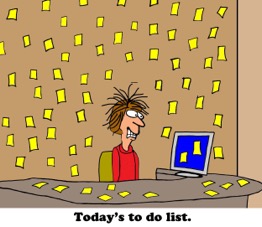 I’m not saying you SHOULDN’T post regular updates (or promotions) to your Facebook page. You definitely should because this type of marketing communication makes your business look alive online. If you’ve ever deliberately checked out a business’s page on Facebook and saw the last update to it was 3 years ago, your first thought probably wasn’t:
I’m not saying you SHOULDN’T post regular updates (or promotions) to your Facebook page. You definitely should because this type of marketing communication makes your business look alive online. If you’ve ever deliberately checked out a business’s page on Facebook and saw the last update to it was 3 years ago, your first thought probably wasn’t:
Wow, this business is on it.
However, your Facebook account needs to generate NEW leads who can become customers. Otherwise, social media can seem like just another task on an already packed to-do list.
Here’s how I recommend you use Facebook:
Run Facebook ads to target your prospects directly, ideally as a part of your overall marketing strategy.
Since only 6% of small businesses with Facebook accounts currently run ads, this means you have a HUGE opportunity to get your marketing message in front of prospects before your competition starts to run their own ads.
 So how can you make sure that your paid advertisements actually generate a response?
So how can you make sure that your paid advertisements actually generate a response?
Facebook ads — just like any other marketing piece — need to be designed and targeted with lead generation in mind in order to create clicks, and ultimately calls and sales for your business.
To help you out, I wrote up how to design AND target your Facebook ad — specifically highlighting how to use Facebook to generate leads that grow your business!
1. Attract qualified prospects with an irresistible special offer
Your Facebook ad MUST include the following:
- An attention-grabbing headline
- Relevant images that communicate what your business does
- A special offer that entices prospects to contact you for it
- And a call to action — so people know HOW to reach you for that special offer.
You want your Facebook ad to quickly communicate your marketing message to your prospect with ZERO delay.
If your prospect has to try and figure out what your marketing means, you’ve already lost them — And they’re scrolling down their newsfeed onto the next update.
Here’s one example of a Facebook ad we created for a client:
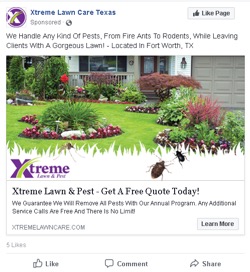
Notice the headline: “Get A Free Quote Today!”
You can put your headline where it is above (below the image), OR you can incorporate it directly into your ad image.
But just FYI:
Facebook doesn’t want your ad’s image to have a ton of text within the actual picture. Facebook will actually show your ad LESS (or not post it at all) if there’s too much text on the image itself.
If your headline takes up more than 20% of the image, you can always put it in the text area. Facebook actually offers an easy way to check if your image has too much text so that you can save time by not waiting for Facebook to potentially disapprove your image (and stop your ad from being shown).
Moving on to imagery…
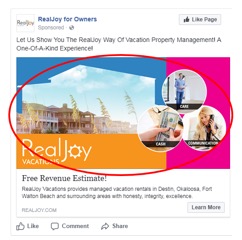 This Facebook ad uses bright graphic colors (love that!) with real photos. I think the result is eye-catching, and I would definitely stop scrolling to take a second peak.
This Facebook ad uses bright graphic colors (love that!) with real photos. I think the result is eye-catching, and I would definitely stop scrolling to take a second peak.
Here are some tips for an image that will stop prospects in their tracks:
- Choose a simple image that’s not too busy
- Use one that’s bright and catches attention
- Make it relevant to your brand & message
In other words: If you’re a dentist, you’re probably not going to use an image like this:

Because that picture most likely doesn’t represent your business, right?
You’d use something more like this:

Because the image of the bright, smiling family conveys health and good dental care for everyone you love!
Plus: Images of people — especially ones where people are looking directly AT the Facebook viewer — will help your prospect connect with your business (and offer).
When it comes to your special offer, you can put it in any part of your text (or image).
Lastly, your call to action can be conveyed with your ad’s button, which prospects will click on to go straight to your website:
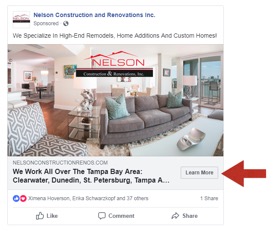
That’s the button, and Facebook lets you customize what it says, but “Learn More” works because it entices someone to click on it to get more information about what’s stated in your ad.
When someone clicks on your ad, here’s what I recommend you do:
Instead of directing them to your website’s homepage, direct them to a landing page.
Sometimes a website has SO many options that, once a brand new visitor arrives, they may get confused and not know what they’re supposed to do.
And rather than spend time figuring out how to navigate your website, many confused prospects will just hit the back button.
Again, if your prospect has to figure out what’s going on with your marketing, you’ve already lost them!
So, you want your landing page to MATCH the details in your Facebook ad…
Meaning this:
- Same design
- Same special offer
- Same colors
- Similar amount of text
- With a clear call-to-action (so they can grab your special offer!)
You want your prospect to arrive to your landing page, KNOW they’ve arrived to the right place, and just enter in their details to contact you!
That’s it — you’ve received a lead.
2. Target your ads for DOUBLE the leads (and potential revenue)
Targeted ads work at least 50% better than ads which aren’t targeted, according to CMO.com — but honestly, I’d bet this statistic is MUCH higher…
Example: If you shout “Kyle!” into a crowd of 1 million people, how many people do you think will respond? But if you shout this guy’s name into a group of 1,000 guys ages 25 to 33 (Kyle is more of a millennial name), do you think you’ll see more heads turn? Of course you will! That’s basically how targeted marketing works.
Facebook offers multiple ways to target the best prospects for your business using:
- Demographics– age, gender, workplace, job titles, etc.
- Location– as close to your business as you like!
- Interests– what people like (hobbies, entertainment, etc.)
- Behaviors– purchase behaviors, which device people are using, etc.
 But this is key:
But this is key:
You want to target your ad’s audience as NARROWLY as possible because a smaller, narrow audience = more targeted.
The more narrowly you target your ads, the more QUALIFIED your prospects (and leads) will be.
Facebook will help you determine how broad or specific your ad is with this helpful little graphic:
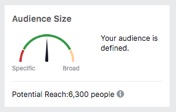 This dial (found in your page’s Ad Manager) will automatically reflect how targeted — or broad — your audience is in Facebook when you’re entering in demographics.
This dial (found in your page’s Ad Manager) will automatically reflect how targeted — or broad — your audience is in Facebook when you’re entering in demographics.
You want that dial somewhere near the middle: too broad means you’re wasting money, and WAY too specific (the red area on the left) means Facebook will not shows your ads (weird, I know).
I recommend you TEST at least 2 ads against each other to see which one gets you the MOST number of clicks to your website (which you can see in Facebook’s ads manager area). You can just spend $10/day for a couple days to watch both ads and see which one produces the most clicks (leads) to your website. This way you keep the one ad running which has proven to get the most amount of attention and clicks to your website.
But remember: Your website must have a way to CAPTURE the leads you send there —
Otherwise, about 96% of people who go to your website (from your paid Facebook ads, for example) will NOT contact you and just disappear instead. So it’s just as important to send people to your website as it is to catch the leads who arrive there.
3. Increase sales by 70% with Facebook remarketing
Remarketing (which means showing your marketing to someone who’s already expressed interest in some way) can increase your sales by up to 70% — which is obviously a lot!
Facebook’s remarketing works by use of the Facebook pixel. The word “pixel” just means a code that goes on your website, and it feeds information about your website’s visitors BACK to Facebook so that you can show ads to these same people on Facebook. Whoever’s in charge of your website should grab your page’s Facebook pixel code and install it on your website right away.
![]()
As long as the Facebook pixel is on your website — Whenever anyone visits your website, they can then see your ads on Facebook.
You may have noticed this phenomenon yourself…
Have you ever noticed after visiting a website, you’re now seeing their ads in your Facebook newsfeed?
That’s remarketing!
Whenever I visit Hotels.com, rest assured I’ll see Hotels.com pop up in my Facebook newsfeed with ads about hotels I may like. This retargeting happens pretty fast for me!
Now remember: Facebook remarketing only works with people who’ve ALREADY visited your website…
In other words, you need to get them to your website FIRST.
That’s why it’s called RE-marketing. You’re marketing a second time so-to-speak, so you need a way to drive people to your website FIRST. That’s where other online ads and direct mail come in, and that’s why direct mail can’t be replaced by Facebook ads.
I did an experiment that was pretty interesting…
I got a mailing list count targeting these folks:
- Living in the Buckhead, GA district in Atlanta
- Gender: female
- Ages 35-55
The mailing list I got targeted the following 6 zip codes:
- 30305
- 30309
- 30324
- 30326
- 30327
- 30342
Note: On Facebook, the lowest radius you can target around a town is 10 miles, but those Buckhead zip codes above only encompass 0.8 square miles! Big difference!
My mailing list count I got provided 13,418 contacts in the above 6 zip codes in Buckhead (with the demographics I listed), yet Facebook only gave me 6,300 people… so, Facebook was short a crazy 7,118 contacts!
Plus, the mailing list count gave me a breakdown of how many contacts are in each 2-year age bracket. See for yourself:
- Ages 34-35: 1,271 contacts
- Ages 36-37: 1,279 contacts
- Ages 38-39: 1,211 contacts
- And so forth up to age 55
(FYI, we provide FREE mailing list counts up to 1,000 records to all small business owners alike at my company, regardless of whether or not you buy from us.)
So, what am I driving at here?
Facebook doesn’t allow you to laser target geographically less than 10 miles…
This means that if you wanted to target just 5 miles surrounding your business, with Facebook alone you COULD NOT do it. Interesting, right? You’d HAVE to use direct mail if you wanted to market to less than a 10-mile radius of your business…
But WHY does this matter? Why would you care if you were marketing 5, 10, or 15 miles out for your marketing?
When I looked at our successful marketing campaigns, specifically the ones that HAD to target to specific locations, ALL of them targeted less than 10 miles.
Of course, not every one of our direct mail campaigns targeted less than 10 miles, but some businesses need to target super locally like this, such as these:
- Dentists
- Gyms
- Mechanics
- Schools
- Restaurants
Are YOU going to drive 10 miles to a basic pizza place if you know there’s one 1 mile from your house? Probably not!
Plus:
When a business locally pinpoints their marketing within a radius less than 10 miles away from their business, we see them receive more leads!
And more leads results in more NEW business.
So the takeaway here is direct mail can provide data and targeting that Facebook still lacks.
Plus, Facebook’s interest targeting can be subjective and not concrete. After all, you can like and comment on parent-like content on Facebook — because maybe in 5 years you want to be a parent, for example — but that doesn’t mean you currently have a child, nor are you worth sending a paid Facebook ad to promoting anything related to children.
But a direct mail mailing list is cut and dry — You either have a kid in the home, or you don’t!
Am I recommending you ditch Facebook ads after everything I’ve said??
NO.
In fact: I actually recommend BOTH direct mail and Facebook ads. Together.
Why? Because above I talked about remarketing with Facebook, and remarketing only works once people are ON your website already, meaning you need to get people to your website FIRST before any remarketing on Facebook will work…
And direct mail can drive the RIGHT people to your website very effectively.
Today, it’s not enough to use one medium to drive people to your website. You need to get your marketing message seen in as many places as possible, particularly where your prospects spend the majority of their time.
Here are the places to concentrate your marketing:
- Their home (where 81% of people check their mail every single day!)
- On infinite internet websites browsing, reading, and shopping
- In their Facebook newsfeeds
- And on mobile with Instagram (35% of adults alone use it!)
This multi-channel approach to marketing and growing your business is your best bet to generating enough qualified leads, consistently, in today’s digital age.
Here’s how I recommend you execute a marketing campaign that touches every place your prospects spend their time:
- Come up with a special offer that your ideal prospects will jump at
- Put that special offer, with matching design, on the following:
- Google ads
- Facebook ads
- Instagram ads
- And a postcard that your prospects don’t need to open to see your special offer
It’s important that your marketing’s designs across your online ads and direct mail pieces MATCH.
That way, regardless of whether a prospect sees your ad online, or in their mailbox on a tangible postcard, they know that message is from the same, on-the-ball business. YOU.
Here’s an example we did so you can see this cohesive marketing strategy:
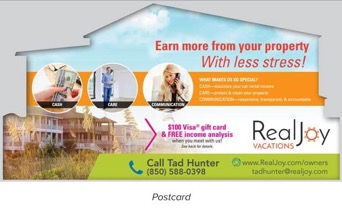
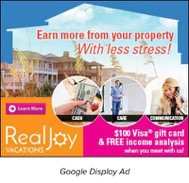
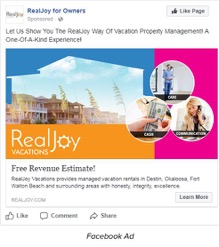 See how the design is consistent from the postcard to the online ads?
See how the design is consistent from the postcard to the online ads?
So, the important question: Does it work? Does it work BETTER?
Decide for yourself…
Here are the results from the above designs for the business, Real Joy Vacations:
- 608 prospect calls so far
- 3,677,023 ad impressions from Google, Facebook, and Instagram
- 3,256 clicks back to their website from their ads
- They’ve picked up 83 properties so far (their original goal was 62!)
So with those results, Real Joy knows for SURE their marketing is growing their business and bottom line. That’s why they’ve been marketing consistently with my company for 6 years straight —
They know that marketing consistently, no fail, is the key to generating enough awareness about their company to create trust in their brand — and calls into their business.
That’s why it’s important to TRACK your results! Tracking can be as simple as creating a spreadsheet (or use this simple download) to record when promotion goes out, and what calls and leads come in as a result.
If all of this multi-channel marketing sounds great — but a bit overwhelming — to you, we developed an all-in-one program called Everywhere Small Business which automatically adds:
- And Instagram ads
- To your targeted direct mail campaign
- Plus, we even track your clicks and new prospect calls in a simple online dashboard (we even record your prospect calls, too!).
You can watch a 1-minute video about Everywhere Small Business here.



